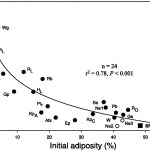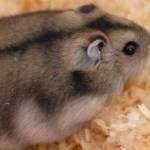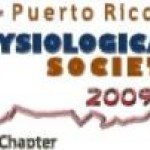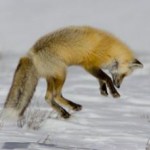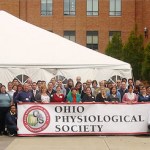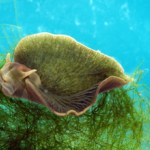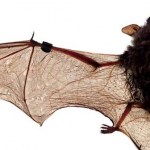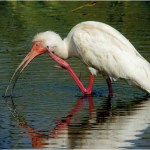
It requires a lot of energy to fast. If I go more than a few hours without eating, I get cranky, a little shaky, and I feel like crawling up into a ball and going to sleep forever. Ok, that was a little bit of an exaggeration, but I can't imagine fasting like a subantarctic fur seal pup, like the one pictured above with it's mother. This study says fur seal pups have to (repeatedly!) go very long periods without eating because the mother seal is rarely around. By very long periods of fasting, I mean anywhere between 4-6 days in most fur seal species. Can you imagine? Mother seals will come…
Dr. Linda Lord at Ohio State University has been studying how cats respond to stress. Her findings show that otherwise healthy cats became ill when stressed whereas cats with a disorder called feline interstitial cystitis (FIC) became healthier when they were less stressed. FIC is a painful disorder that causes inflammation of the bladder in cats and can lead to the formation of crystals that spread to the urethra.
According to the researchers, signs of stress in cats include: vomiting, decreased appetite, as well as urinating or defecating outside of the litterbox (gross!).
Cats recruited…
I'm not a huge winter fan. I don't like the cold, and I don't like just a few measly hours of sunlight. That's probably why I live in the southwest. But despite that, I still find myself feeling more lethargic in the winter than in the summer. It turns out this is pretty common. More severe cases, involving bouts of depression, is actually diagnosable. It's called Seasonal Affective Disorder (appropriately shortened to SAD). SAD is a mood disorder in which individuals have normal mental wellbeing during most of the year, but then have more "depressive" symptoms in the winter and during times…
Recently, The New York Times published an article about the difficulties local science fairs have had securing funding to support their events. Some of the funding woes stem from state budget cuts whereas others result from sponsors no longer being able to provide support.
Science fairs, in my opinion, are highly valuable experiences for bright young students to begin to develop an appreciation for science and technology as they test their own hypotheses. I have had the privilege of judging numerous student presentations at local science fairs and have always been impressed by their…
The last stop on our trip across America is the the youngest local chapter of The American Physiological Society, the Puerto Rico Physiological Society, established in 2009. This chapter held their inaugural meeting on February 4th at the University of Puerto Rico in San Juan.
Here are some highlights from the meeting:
Chapter President Dr. Nelson Escobales welcomes everyone to the 1st inaugural meeting:
The keynote address was given by Dr. Elizabeth McNally from the University of Chicago Medical Center, who studies the inheritance of heart and muscle diseases that lead to weakness.
Dr.…
Next stop: The Gulf Coast Physiological Society, founded in 1999 and comprised of physiologists in Louisiana, Mississippi and Alabama. This local chapter of The American Physiological Society met in 2009 to discuss physiology research in their region.
The Keynote Address was provided by Dr. Mark Gladwin at the University of Pittsburgh
School of Medicine, who presented his research on how nitrate is involved in cardiovascular physiology.
There were so many excellent talks at this meeting that I will just highlight a few that I found particularly interesting:
Fridrik Karlsson, a graduate…
No, we are not talking about mating habits here. We are talking about the ability of some animals to use the Earth's magnetic field to navigate and in the case of foxes, to find prey. In a recent article published in New Scientist, foxes have been identified as the first animal believed to use the Earth's magnetic field for more than simply determining which direction they are heading. While Dr. Hynek Burda from the University of Duisburg-Essen, Germany was observing the animals, he noticed that when the prey was hidden, the foxes almost always jumped on their prey in a northeast direction…
I'm really afraid of bees. I've only been stung once, and after 2 seconds of pure torture, I thought the end of the world was approaching. Now I'm reading that there might be a way to use bee venom to help individuals with multiple sclerosis and arthritis... by voluntarily being stung! It sounds crazy, but it's been shown to help some individuals.
This video from National Geographic shows the journey of one woman with multiple sclerosis undergoing Bee Sting Therapy (also known as Bee Venom Therapy). She got up to 200 honey bee stings per week (I'm blacking out, hold on one second... OK, I'm…
Next stop: Tennessee, where the Tennessee Physiological Society held their annual meeting on October 14-15, 2010 at the University of Tennessee Health Science Center.
Dr. Polly Hofmann, The University of Tennessee Health Science Center kicked off the meeting with a presentation on myocardial ischemia, which is when the blood supply to the heart muscle is reduced.
Dr. Tom Ecay from East Tennessee State University then presented his research on the importance of calcium during embryonic development.
Dr. Kevin Currie at Vanderbilt University Medical Center then presented his research on how…
The next stop on our journey is the Ohio Physiological Society, which was created 25 years ago and held their annual meeting October 14-15, 2010. This local chapter of The American Physiological Society has gone regional! Not only did the meeting attract scientists and students from 14 universities in Ohio, but also neighboring Henry Ford Hospital, University of Pittsburgh, University of Michigan and Wayne State University in Michigan. The meeting kicked off with welcoming comments provided by Dr. Martin Frank, the Executive Director of The American Physiological Society, Dean Pamela Davis…
The next stop on our journey visiting local chapters of The American Physiological Society is Oklahoma. The Oklahoma Society of Physiologists is comprised of scientists, educators and students who are promoting physiology research and education. In fact, the topic of their 2009 meeting was on the responsible conduct of research, a topic every scientist and student should learn. I look forward to seeing future conference topics from this local chapter of The American Physiological Society!
For all of the cat lovers out there, this entry is for you! You may recall the recent post on how dogs are smarter than cats. Admittedly, I love our little feline friends as well although my cat is certainly no Einstein...more like Garfield...
Based on the ratio of brain to body size size alone, cats have larger brains than dogs, but now we may also know how so many mice and birds outsmart our furry little friends:
Many cat owners will tell you stories of their pets being able to open windows and doors, especially if that door leads to their food or to cozy blankets and towels in a cabinet…
Being able to count may be innate to many species. An article in New Scientist featured 8 amazing animals that are able to count or distinguish between ratios. Here are their stories:
Red-backed salamanders: Dr. Claudie Uller at the University of Essex, UK tested the counting ability of these amphibians in Louisiana. The animals were able to pick out tubes containing 1, 2, or 3 flies but could not tell the difference between 3 and 4 flies. If the ratio of flies in each tube was greater than 2 to 1, they could also discriminate up to 16 flies in each tube.
Newborn chicks: Rosa Rugani and…
Arguably one of the most ambitious ongoing projects is Genome 10K. The goal of this project is to develop a database containing the DNA sequences for 10,000 vertebrate species. According to the website, this comes out to roughly one sequence for every vertebrate genus.
Completion of this database would provide an invaluable resource for researchers, veterinarians, students and anyone else interested in the DNA sequences of assorted vertebrates. Those tasked with completing the project include leading scientists from zoos, museums, research centers and universities world-wide.
There are…
Image: NewScientist; 11, Dec. 2010 issue; "Dawn of the Plantimals"
I have read a lot recently about the photosynthesizing capabilities of animals, and why most animals simply don't do it. I personally thought this luxury was awarded only to plants - you know, almost as a pity: "Hey, plants, sorry you're stuck in one place, but at least you can obtain energy directly from sunlight!" As it turns out, there are several small animals that use photosynthesis to live!
So let's talk about the idea of photosynthesis in animals. This means that animals (animals is actually a euphemism here for…
After reading the article on the decimation of bat populations in North America, that was the subject of my previous entry, I wanted to learn more about these incredible flying mammals. There is actually a whole website called Bat Web dedicated to the understanding of bats where you can watch a video presented by John O. Whitaker at Indiana State University on just how amazing bats are.
Perhaps the most intriguing aspect of bats is their ability to echolocate while simultaneously hunting prey. To find out more about how the brains of bats process sounds, I read a press release from The…
Many of you have probably been following the news on the recent deaths of thousands of blackbirds in Arkansas that have, so far, been attributed to confusion brought on by local fireworks causing the birds to fly into objects. You are probably also aware of the mysterious deaths of more birds in Lousiana just a few days after the Arkansas incident. The underlying cause of these mass deaths is under investigation since tests of the carcasses for potential toxins or diseases are still underway.
Equally mysterious are the deaths of numerous fish in Arkansas, Maryland, Brazil, and New Zealand…
Dr. Peter Frederick at the University of Florida has discovered that not only does mercury pollution lower testosterone levels in white ibises (pictured above), it also has resulted in the male birds mating with each other. His findings are published in the Proceedings of the Royal Society.
Dr. Frederick fed the birds a diet with varying concentrations of mercury (0.05-0.3 ppm wet weight) for three years. What he found was that 55% of the males in the highest dose group nested with other males and egg productivity dropped to 30%.
These findings demonstrate the profound impact the…
Next stop: Iowa. The Iowa Physiological Society, a local chapter of The American Physiological Society, held their 15th annual meeting on Saturday October 9th at Des Moines University.
Here are some of the comparative physiology highlights from their annual meeting:
The Lizard "Kiss and Run": The main method of neurotransmitter release is usually thought to occur by exocytosis where a vesicle, which holds the neurotransmitters, fuses with the plasma membrane of a cell and releases its contents into the fluid outside of the cell. Some vesicles, however, have been described as only…
The next stop on our journey visiting local chapters of The American Physiological Society is Nebraska. The Nebraska Physiological Society was founded in 1997 and just held their 13th meeting on September 11, 2010 in Omaha. If I only lived in Nebraska I would have been able to listen to Dr. Hannah Carey from the University of Wisconsin speak about hibernation! Dr. Carey is a well-known comparative physiologist who specializes in gastrointestinal physiology and hibernating animals. What a great start to a meeting!
Here are some other highlights from the 13th annual meeting of the Nebraska…
